|
Alaska's Fall Foliage & Aurora Viewing Driving Tour! The short fall season is a perfect time to visit Alaska - the birch trees are turning into a stunning gold and the tundra is ablaze in a sea of red. Moose and caribou have shed their antler's velvet and skies are usually clear and deep blue. Amidst this background of brilliant color you'll travel from Anchorage up the Parks Highway via Talkeetna to Denali National Park and bus through one of the best wildlife viewing areas in North America to the Eielsen Visitor Center or to the Toklat area. Moose, Dall sheep, and caribou are usually seen on this trip. Of course, if Mt. McKinley is out, the view of mountain alone is worth the trip. You'll spend a couple of days in Denali because the Park belongs also to the best destinations in the world to view and photograph Grizzly Bears during fall. The grizzly bears are in their prime from the middle of August until the end of September; their bodies are flush and fat with rich salmon from the summer, their coasts filling out for the long cold winter ahead, these bears fairly glow in the waning fall light. Continue your journey on the Parks Highway to Fairbanks and Chena Hot Springs. September is one of the best time to watch the Aurora Borealis (Northern Lights) The month combines both mild weather and dark skies. |
Alaska Fall Foliage and Aurora Borealis Driving Tour (AK-WSD03)
Tour Itinerary
Dates | Rates
Options | Extensions
Self Drive FAQ
Destination Information
|
Day
01 |
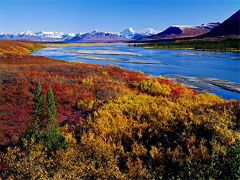 |
Anchorage - Talkeetna Pick up your rental car in Anchorage. Enjoy sweeping views of snowcapped mountain peaks in the distance while traveling from Anchorage on the George Parks Highway to Wasilla. Visit the Iditarod Headquarter in Wasilla and check out how tough "The Last Great Sled Dog Race on Earth" really is. Continue to Talkeetna: Talkeetna was established as a mining town and trading post before either Wasilla or Anchorage existed. Several of its old log buildings are today historical landmarks. The community is internationally recognized as the base for many of the climbing expeditions that challenge Mt. McKinley during the summertime. The Talkeetna and Chulitna Rivers join the Susitna River at Talkeetna and the town reportedly takes its name from an Indian word meaning "where the rivers join". Distance: 120 Miles |
|
Day
02 |
 |
Talkeetna - Denali National Park This morning join a scenic flightseeing tour to Mt. McKinley. This magnificent flight takes you within six miles of Mt. McKinley's summit. Enter a world of rugged high mountain peaks and wide glacier filled valleys. See the Sheldon Amphitheater, beautiful Ruth Glacier, and the Great Gorge. Leave Talkeetna and follow the Parks Highway through Denali State Park with good wildlife viewing, canoe rental and excellent hiking opportunities. Arrive at Denali National Park during the day and check in your hotel. Denali, the “Great One”, is the name Athabascan people gave the massive peak that crowns the 600-mile-long Alaska Range. Denali National Park and Preserve was created 1980 from the former Mt Mc.Kinley National Park. At over 6 million acres, the park is larger than the State of Massachusetts. It exemplifies interior Alaska’s character as one of the world’s last great frontiers for wilderness adventure and it remains largely wild and unspoiled, as the Athabascan knew it. Distance: 110 Miles |
|
Day
03 |
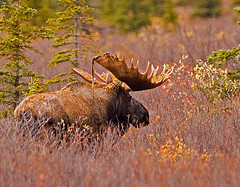 |
Denali National Park Early departure (pre-reserved time) for a full day national park and wildlife observation tour within the shadows of 20.320 foot Mt. McKinley to Toklat or Eielson Visitor Center with a immense view of “ the Mountain”. Watch out for grizzly bears, moose, caribou, wolf and fox moving along the ridges and riverbeds or observe one of the 150 different bird species which inherit the park area. From the park road you enjoy great hiking opportunities. Return to the Denali Park entrance anytime during the day. Overnight: Denali National Park |
|
Day
04 |
 |
Denali National Park - Fairbanks Short drive via Nenana (Alaska Ice Classics) to Fairbanks. Fairbanks, known as the Golden Heart City of Alaska, is the gateway to the interior and features almost 24 hours of daylight during the summer months. Explore the local gold rush history, its vibrant traditional native cultures as well as its abundant wildlife and fantastic scenery. Tucked into miles of unexplored wilderness only 120 miles from the Arctic Circle, Fairbanks offers excellent year-round outdoor recreational opportunities. This afternoon you may visit the renown Alaska University Museum with the best statewide history collection, Alaskaland or take an authentic sternwheeler on a scenic 20-mile roundtrip cruise down the Chena and Tanana Rivers. Enjoy lively narration, stop at a reconstructed Athabascan Indian Village to learn about native hunting and fishing techniques and watch a dogsled demonstration. Optional: Evening Aurora viewing. Distance: 120 Miles |
|
Day
05 |
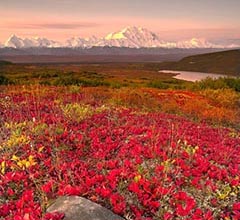 |
Fairbanks You have many options to spend the day. Visit the sights of Fairbanks, travel to North Pole or join the full day aurora fly & drive tour to the Arctic Circle. This tour takes you on a scenic flight from Fairbanks to Coldfoot, north of the Arcitic Circle in the Brooks Mountain Range. Join your group for a scenic tour along the Dalton Highway back to Fairbanks. Learn the story of Alaska's Arctic both while traveling in the tour vehicle and at the various stops along the way. View the remarkable Trans Alaska Pipeline and cross the Arctic Circle in ceremonious fashion and receive an official Arctic Circle Adventure Certificate. Witness firsthand the remarkable wilderness which is Alaska's Arctic. Stop along the shores of the mighty Yukon River. Once the sky gets dark, make stops to scan the northern sky for the aurora. Return to Fairbanks around 3:00 am. |
|
Day
06 |
 |
Fairbanks - Chena Hot Springs Resort Drive along the Chena Hot Springs road (watch out for moose!), take a hiking trip along the Chena River and enjoy the Chena Hot Springs Resort. This is the favorite place up north to relax in a large heated indoor pool or in the natural outdoor rock lake. Visit the Aurora Ice Museum and grant yourself to a "Appletini" beverage served in an ice glass and last but not least stay up and watch out for the nightly Northern Lights spectacle on the sky above you. Distance: 60 Miles |
|
Day
07 |
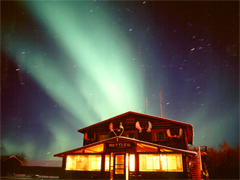 |
Chena Hot Springs Resort Enjoy your day at Chena Hot Springs Resort. The area is internationally recognized as one of the best places to view the Aurora Borealis in Alaska. The 440-acre resort area is also known for its healthy outdoor opportunities in the pristine wilderness of Alaska´s great Interior. Spend your day at leisure and join a guided ATV Tour, go on a hiking trip, horseback riding or biking. Throughout the sumner, snowless summer month, guests get to experience the traditional winter Alaskan sport of dog mushing during a dog cart ride - or visit the dog kennel and chat with an experienced mushers. Tonight you have the opportunity again to observe the Northern Lights dancing across the northern winter skies. The area offers some of the best Northern Lights viewing in the world made possible by the right weather and clear skies. Beautiful and mysterious curtains, the colors range from green to red to purple, with the brightest and most common color, a yellow-green. |
|
Day
08 |
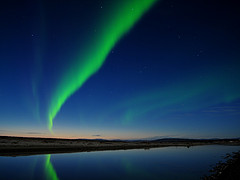 |
Chena Hot Springs Resort - Fairbanks After breakfast spend some time to enjoy Chena Hot Springs Resort facilities. Return to Fairbanks and drop off your rental car at the airport. Flight reservations to your home destination should be arranged preferably after 10:00 am. Optional: We can arrange for you the Alaska Railroad journey back to Anchorage. Distance: 60 Miles |
| Rates in US $ / per Person | Single | Double | Triple | Quad |
| August 20 - August 31 | $ 2540.00 | $ 1315.00 | $ 955.00 | $ 760.00 |
| September 01 - September 20 | $ 2120.00 | $ 1095.00 | $ 785.00 | $ 630.00 |
| Rates in US $ / per Person | Single | Double | Triple | Quad |
| August 20 - August 31 | $ 3050.00 | $ 1550.00 | $ 1099.00 | $ 870.00 |
| September 01 - September 20 | $ 2470.00 | $ 1275.00 | $ 920.00 | $ 735.00 |
| Daily Departures from August 20 - September 20 |
|
| Rates in US $ | per Person | Adult |
| Talkeetna: 1 hr Mt. McKinley Flightseeing Tour (Glacier Landing: add $85) | $ 205.00 |
| Fairbanks: Arctic Circle Aurora Fly Drive Adventure (1 PM - 4 AM) | $ 469.00 |
| Fairbanks: Arctic Circle Aurora Drive / Drive Adventure (2 PM - 4 AM) | $ 220.00 |
| Chena: 45 Minute ATV Tour | $ 80.00 |
| Rental Car Category | Rental Car Type | Tour Upgrade | Additional Day |
| Compact Car | Chevrolet Aveo or similar | Included | $ 115.00 |
| Mid Size Car | Toyota Corolla or similar | $55.00 | $ 120.00 |
| Full Size Car | Chevrolet Malibu or similar | $99.00 | $ 125.00 |
| Fullsize SUV | Jeep Grand Cherokee or similar | $560.00 | $ 187.00 |
| Mini Van | Dodge Grand Caravan or similar | $560.00 | $ 187.00 |
| Rates include Taxes, Unlimited Free Mileage | |||
| Rates in US $ | per Person | Hotel Category | Single | Double | Triple | Quad | Child |
| May 15 - May 31 | Superior Hotel | $135.00 | $68.00 | $49.00 | $40.00 | $10.00 |
| June 01 - August 31 | Superior Hotel | $150.00 | $80.00 | $55.00 | $45.00 | $10.00 |
| September 01 - September 15 | Superior Hotel | $135.00 | $68.00 | $49.00 | $40.00 | $10.00 |
| May 15 - May 31 | First Class Hotel | $170.00 | $85.00 | $65.00 | $55.00 | $10.00 |
| June 01 - August 31 | First Class Hotel | $220.00 | $110.00 | $80.00 | $60.00 | $10.00 |
| September 01 - September 15 | First Class Hotel | $170.00 | $85.00 | $65.00 | $55.00 | $10.00 |
| Alaska Sightseeing Destinations | |||||||
 Anchorage |
 Fairbanks |
 Juneau |
 McCarthy |
 Homer |
 Seward |
 Cooper Landing |
 Talkeetna |
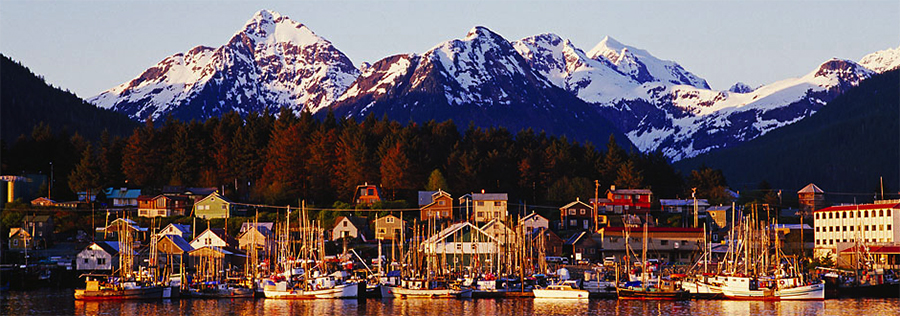 |
||||||||||||||||||||||||||||||||||||||||||||||||||||||||||||||||||||||||||||||||||||||||||||||||||||||||||||||||||||||||
Self Drive Tours Information - FAQ
|
||||||||||||||||||||||||||||||||||||||||||||||||||||||||||||||||||||||||||||||||||||||||||||||||||||||||||||||||||||||||
 |
|
| Staff Travel Picks and Destination Roundup Anchorage Anchorage: Is by far Alaska's largest and most sophisticated city, Anchorage is situated in a truly spectacular location. The permanently snow-covered peaks and volcanoes of the Alaska Range lie to the west of the city, part of the craggy Chugach Range is actually within the eastern edge of the municipality, and the Talkeetna and Kenai ranges are visible to the north and south. On clear days Mt. McKinley looms on the northern horizon, and two arms of Cook Inlet embrace the town's western and southern borders. The Native Heritage Center: There are more than 200 Native tribal entities in Alaska. At the Heritage Center, experience the lifestyles and traditions of these Native cultures through art and artifact displays and activities like blanket tossing, parka sewing, and drumming. Portage Glacier: This glacier has been receding rapidly, but you can ride the tour boat Ptarmigan across the lake to view its face. Keep an eye out for office building-size chunks of ice falling into the water. Flattop Mountain: Drive to the Glen Alps parking lot in Chugach State Park and take the short walk west to a scenic overlook on a clear day the view sweeps from Denali south along the Alaska Range past several active volcanoes on the other side of Cook Inlet. Or follow the hikers to the top of the mountain for even more stunning scenery. Native Crafts: Alaska's rich Native culture is reflected in its abundance of craft traditions, from totem poles to intricate baskets and detailed carvings. Many of the native crafts you'll see across the state are results of generations of traditions passed down among tribes; the craft process is usually labor-intensive, using local resources such as rye grasses or fragrant cedar trees. Each of Alaska's native groups is noted for particular skills. Inuit art includes ivory carvings, spirit masks, dance fans, baleen baskets, and jewelry. Also be on the lookout for mukluks (seal- or reindeer-skin boots). The Tlingit peoples of Southeast Alaska are known for their totem poles, as well as for baskets and hats woven from spruce root and cedar bark. Tsimshian Indians also work with spruce root and cedar bark, and Haida Indians are noted basket makers and carvers. Athabascans specialize in birch-bark creations, decorated fur garments, and beadwork. The Aleut, a maritime people dwelling in the southwest reaches of the state, make grass basketry that is considered among the best in the world. |
|
 |
|
| Talkeetna | Denali National Park Denali National Park: is one of the most popular and most visited destinations for a reason: the most accessible of Alaska's national parks and one of only three connected to the state of Alaska highway system. This is a spectacular and scenic 6-million-acre wilderness region offering views of mountains so big they seem like a wall on the horizon, endless wildlife from cinnamon-colored Toklat grizzlies to herds of caribou, to moose with antlers the size of coffee tables and glaciers with forests growing on them. All can be experienced by saddle safari, bus trip, or flightseeing tour. Hike, bike, stroll, or raft through it. Camp out, or bundle up in a cabin. The first 15 mi of the park road are paved, but after that there's just gravel. Visitors must ride on a bus or get off and see Denali on foot. No matter how you get there or which adventure you choose, Denali is truly a wonderful experience. When planning your trip consider whether you want to strike out on your own as a backcountry traveler, or to stay at a lodge nearby and enjoy Denali on day hikes and by shuttle bus. Either option requires some individual advance planning or simply contact us and book one of our package tours with hotel or backcountry lodge overnights, railroad transportation from Anchorage and sightseeing tours. Talkeetna: For the ultimate mountain sightseeing adventure, take a flight from Talkeetna and land on a glacier—if you're early enough in the summer, you can fly onto the Kahiltna Glacier, where teams attempting to summit the mountain gather. Mount McKinley: There are a dozen places between Anchorage and Fairbanks that boast the best viewing of Mt. McKinley. At 20,320 feet, McKinley is the highest peak in North America, and just about any place within 100 mi can be deemed a good viewing area. The crown jewel of Alaska is often shrouded in clouds, but even a glimpse will reveal the sheer size of the snow-covered giantess. |
|
| The Inside Passage | Juneau | Glacier Bay National Park If you don't arrive in Alaska by cruise ship, make a point of taking a ferry trip along the longest, deepest fjord in North America. Depending on which ferry you take, the trip from Juneau to Skagway can be two or six hours long. We recommend taking your time. In the summer the tall peaks surrounding the boats release hundreds of waterfalls from snow and glacial melt. If you're lucky, you'll see pods of orcas, humpbacks, and dolphins. Mt. Roberts, Juneau: The tram takes you up the mountain and, if the weather cooperates, offers great views of the area. It's another cruise-ship favorite, but at least you can have a quick beer as you soak in the scenery. Mendenhall Glacier, Juneau: This drive-up glacier comes complete with visitor center, educational exhibits, nature trails, and, when the cruise ships are in town, lots of bused-in tourists. Don't let the crush of visitors dissuade you from stopping by, though—it's a great resource for learning about glacier dynamics and the natural forces that have shaped Alaska. Glacier Bay National Park | Gustavus: Whether you view this natural wonder by air, boat, or on foot, Glacier Bay is well worth the effort and expense it takes to get there. Gustavus is the gateway to Glacier Bay, the place that the father of the national parks system, John Muir, called "unspeakably pure and sublime" in 1879. It is considered by many to be 70 mi of the finest sea kayaking in the world. The first 24 square mi comprise the Beardslee Islands, a complex system for kayakers who glide atop flat water between tides, enveloped in silence except for the sound of water slapping paddles, the soft spray from a nearby porpoise, and the howl of a wolf in the distance. And you'll likely be enjoying these sights with no other travelers nearby. Still, kayaking in this region presents challenges. There is a lively population of moose and bears on the islands, so it is imperative to choose wisely when setting up camp. Most visitors kayak only to the top of the Beardslees, which can take three to five days round-trip. Alaska Marine Highway System: The ferry provides access twice a week to Gustavus. |
|
| The Kenai Peninsula - Alaska‘s Playground Kenai Fjords National Park: Photogenic Seward is the gateway to the 670,000-acre Kenai Fjords National Park. This is spectacular coastal parkland incised with sheer, dark, slate cliffs rising from the sea, ribboned with white waterfalls, and tufted with deep-green spruce. Kenai Fjords presents a rare opportunity for an up-close view of blue tidewater glaciers as well as some remarkable ocean wildlife. Seward, Exit Glacier: You can take a short, easy walk to view this glacier, or if you're in the mood for a challenge, hike the steep trail onto the enormous Harding Icefield. Scan the nearby cliffs for mountain goats and watch for bears. Seward Sea-Life Center: Spend an afternoon at the Alaska SeaLife Center, with massive cold-water tanks and outdoor viewing decks as well as interactive displays of cold-water fish, seabirds, and marine mammals, including harbor seals and a 2,000-pound sea lion. A research center as well as visitor center, it also rehabilitates injured marine wildlife and provides educational experiences for the general public. Appropriately, the center was partially funded with reparations money from the Exxon Valdez oil spill. Films, hands-on activities, a gift shop, and behind-the-scenes tours ($12 and up) complete the offerings. Homer: at the southern end of the Sterling Highway lies the city of Homer, at the base of a narrow spit that juts 4 mi into beautiful Kachemak Bay. Glaciers and snowcapped mountains form a dramatic backdrop across the water. Protruding into Kachemak Bay, Homer Spit provides a sandy focal point for visitors and locals. A paved path stretches most of the 4 mi and is great for biking or walking. A commercial-fishing-boat harbor at the end of the path has restaurants, hotels, charter-fishing businesses, sea-kayaking outfitters, art galleries, and on-the-beach camping spots. Fly a kite, walk the beaches, drop a line in the Fishing Hole, or just wander through the shops looking for something interesting; this is one of Alaska's favorite summertime destinations.Kachemak Bay: abounds with wildlife, including a large population of puffins and eagles. Tour operators take you past bird rookeries or across the bay to gravel beaches for clam digging. Most fishing charters include an opportunity to view whales, seals, porpoises, and birds close up. At the end of the day, walk along the docks on Homer Spit and watch commercial fishing boats and charter boats unload their catch. Halibut Cove: Directly across from the end of Homer Spit is Halibut Cove, a small artists' community. Spend a relaxing afternoon or evening meandering along the boardwalk and visiting galleries. The cove is lovely, especially during salmon runs, when fish leap and splash in the clear water. Several lodges are on this side of the bay, on pristine coves away from summer crowds. The Danny J ferries people across from Homer Spit, with a stop at the rookery at Gull Island and two or three hours to walk around Halibut Cove. The ferry makes two trips daily: the first leaves Homer at 12:00 pm and returns at 5:00 pm, and the second leaves at 5:00 pm and returns at 10:00 pm.
|
|
| The Winter Wonderland | Aurora Viewing | Skiing | Dog Mushing The most popular attraction in the wintertime doesn't charge admission or have set viewing times. The Northern Lights (Aurora Borealis) seem to appear without rhyme or reason. There is a science to it, but explanations are still hotly debated by meteorologists, astronomers, and pretty-color enthusiasts. Seeing the northern lights requires that there be no nearby city light, very little moonlight, the cold fall and winter months, and a lot of luck. Hot springs outside Fairbanks keep the hopeful warm while they watch the skies. There is something about the incongruous number of hours of sunlight and darkness Alaska gets that makes Alaskans yearn to break the rules of time. When you arrive in Alaska you may feel inclined to do the same. In many parts of the state bars still stay open all night long, fishermen can be sitting on the ice all hours of the night, and some people ski best when the witching hour strikes. At Alyeska Ski Resort in Girdwood, skiers can take the lift and bite the powder under the stars. On weekends this popular ski resort offers night skiing, and afterwards, in the bar, rewards its visitors with live, high-energy, danceable music. This provides a good look at local Alaskan culture, as it caters to tourists and residents alike. |
|
| Alaska's Top Bear Viewing Destinations Katmai National Park | Brooks River: When people come to Alaska they want to see bears. Yet most visitors never get a glimpse, because bears prefer their privacy. But at Katmai National Park, which boasts the largest brown bear population in the world, you're almost guaranteed a photograph of bears doing bear things. Remember, although they look cute, their teeth and claws are still mighty sharp. Kodiak Island: The 1.9-million-acre Kodiak National Wildlife Refuge lies mostly on Kodiak Island and neighboring Afognak and Uganik islands, in the Gulf of Alaska. All are part of the Kodiak Archipelago, separated from Alaska's mainland by the stormy Shelikof Strait. Within the refuge are rugged mountains, tundra meadows and lowlands, thickly forested hills that are enough different shades of green to make a leprechaun cry, plus lakes, marshes, and hundreds of miles of pristine coastland. No place in the refuge is more than 15 mi from the ocean. The weather here is generally wet and cool, and storms born in the North Pacific often bring heavy rains. Dozens of species of birds flock to the refuge each spring and summer, including Aleutian terns, horned puffins, black oystercatchers, ravens, ptarmigan, and chickadees. At least 600 pairs of bald eagles live on the islands, building the world's largest bird nests on shoreline cliffs and in tall trees. Seeing the Kodiak brown bears alone is worth the trip to this rugged country. When they emerge from their dens in spring, the bears chow down on some skunk cabbage to wake their stomachs up, have a few extra salads of sedges and grasses, and then feast on the endless supply of fish when salmon return. About the time they start thinking about hibernating again the berries are ripe (they may eat 2,000 or more berries a day). Kodiak brown bears, the biggest brown bears anywhere, sometimes topping out at more than 1,500 pounds, share the refuge with only a few other land mammals: red foxes, river otters, short-tailed weasels, and tundra voles. Six species of Pacific salmon - chums, kings, pinks, silvers, sockeyes, and steelhead—return to Kodiak's waters from May to October. Other resident species include rainbow trout, Dolly Varden (an anadromous trout waiting for promotion to salmon), and arctic char. The abundance of fish and bears makes the refuge popular with anglers, hunters, and wildlife-watchers. Lake Clark National Park | Redoubt Bay When the weather is good, an idyllic choice beyond the Mat-Su Valley is the 3.4-million-acre Lake Clark National Park and Preserve, on the Alaska Peninsula and a short flight from Anchorage or Kenai and Soldotna. The parklands stretch from the coast to the heights of two grand volcanoes: Mt. Iliamna and Mt. Redoubt (which made headlines in 2009 when it erupted, sending ash floating over the region), both topping out above 10,000 feet. The country in between holds glaciers, waterfalls, and turquoise-tinted lakes. The 50-mi-long Lake Clark, filled by runoff waters from the mountains that surround it, is an important spawning ground for thousands of red (sockeye) salmon. The river-running is superb in this park. You can make your way through dark forests of spruce and balsam poplars or hike over the high, easy-to-travel tundra. The animal life is profuse: look for bears, moose, Dall sheep, wolves, wolverines, foxes, beavers, and mink on land; seals, sea otters, and white (or beluga) whales offshore. Wildflowers embroider the meadows and tundra in spring, and wild roses bloom in the shadows of the forests. Plan your trip to Lake Clark for the end of June or early July, when the insects may be less plentiful. Or consider late August or early September, when the tundra glows with fall colors. |
|
| Wrangell St. Elias National Park In a land of many grand and spectacularly beautiful mountains, those in the 9.2-million-acre Wrangell-St. Elias National Park and Preserve are possibly the finest of them all. This extraordinarily compact cluster of immense peaks belongs to four different mountain ranges. Rising through many ecozones, the Wrangell-St. Elias Park and Preserve is largely undeveloped wilderness parkland on a grand scale. The area is perfect mountain-biking and primitive-hiking terrain, and the rivers invite rafting for those with expedition experience. The mountains attract climbers from around the world; most of them fly in from Glennallen or Yakutat. The nearby abandoned Kennicott Mine is one of the park's main visitor attractions. The open pit mine is reminiscent of ancient Greek amphitheatres, and the abandoned structures are as impressive as the mountains they stand against. |
|
| Prince William Sound Tucked into the east side of the Kenai Peninsula, the sound is a peaceful escape from the throngs of people congesting the towns and highways. Enhanced with steep fjords, green enshrouded waterfalls, and calving tidewater glaciers, Prince William Sound is a stunning arena. It has a convoluted coastline, in that it is riddled with islands, which makes it hard to discern just how vast the area is. The sound covers almost 15,000 square mi—more than 12 times the size of Rhode Island—and is home to more than 150 glaciers. The sound is vibrantly alive with all manner of marine life, including salmon, halibut, humpback and orca whales, sea otters, sea lions, and porpoises. Bald eagles are easily seen soaring above, and often brown and black bears, Sitka black-tailed deer, and gray wolves can be spotted on the shore. Unfortunately, the Exxon Valdez oil spill in 1989 heavily damaged parts of the sound, and oil still washes up on shore after high tides and storms. The original spill had a devastating effect on both animal and human lives. What lasting effect this lurking oil will have on the area is still being studied and remains a topic of much debate. Bring your rain gear, Prince William Sound receives more than 150 inches of rain per year. The sound is best explored by charter boat or guided excursion out of Whittier, Cordova, or Valdez. Even though the waters are mostly protected, open stretches are common, and the fickle Alaska weather can fool even experienced boaters. From the road system, Whittier and Valdez are your best bets for finding charter outfits.
|
|